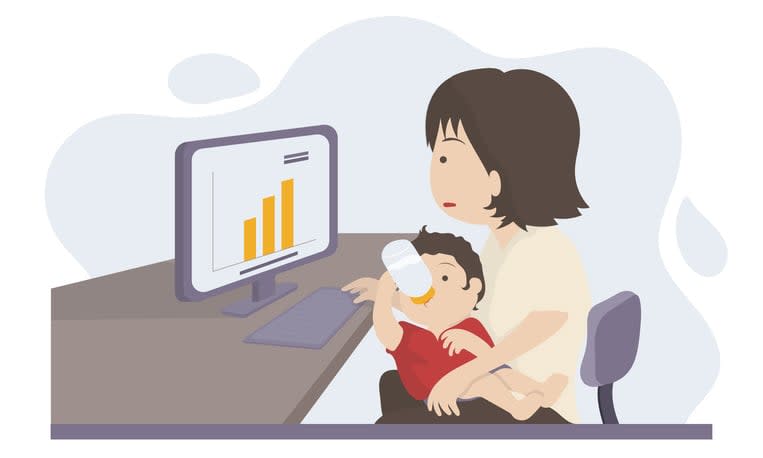A remote job allows you to work from a location other than the traditional office. This could be your home, a coworking space, or even a cafe. In this article, we’ll detail what remote jobs are, how they differ from telecommuting, the benefits and challenges, and how to find and succeed in one.
Key Takeaways
- Remote work allows employees to perform their job outside a traditional office setting, offering flexibility in choosing their work environment and schedule.
- The primary benefits of remote jobs include improved work-life balance, reduced stress, and increased employee productivity, while employers gain cost savings and access to a wider talent pool.
- Effective remote work requires managing potential challenges such as isolation, maintaining productivity, and proper time management, emphasizing communication tools and creating a conducive home office environment.
Defining remote work

Remote work allows you to perform your job outside the confines of a traditional office setting. Typically using a notebook PC or mobile device, most remote workers can act as if they are in the office using software and collaboration tools to perform work.
This flexible working arrangement enables remote workers to tap into their most productive selves by choosing their work environment— from the comfort of home, a local coworking space, or while sipping a latte at a favorite eatery. Remote work means that the typical 9-to-5 grind and daily commute are replaced by a tailored schedule that fits your life and responsibilities.
With reliable connectivity and robust communication tools, remote teams can collaborate effectively, regardless of physical location, focusing on outcomes rather than office attendance. Apps like Kumospace enable teams to build an ideal or fantastic version of the office, with a coffee bar, beac, and all the private or group office space they need to achieve work through prompt collaboration.
Remote work vs. telecommuting
While the terms remote work and telecommuting are often used interchangeably, there’s a subtle yet significant difference between them. Telecommuting usually refers to a flexible working arrangement where an employee may work from home or a location close to home, but not necessarily on a full-time basis. It could be a temporary or part-time situation, allowing for some in-office presence.
On the other hand, remote work encompasses a broader spectrum, often implying that an individual is working remotely most or all of the time, potentially from a different city or even country, with the traditional office being an occasional touchpoint at best.
Levels of remote work
The extent to which one works remotely can vary widely, depending on both personal preference and employer needs. Some may opt for a hybrid model, splitting their time between the office and a remote location, while others may go fully remote, foregoing the office entirely. The level of remoteness can deeply impact your work-life balance and daily routine, with fully remote employees enjoying the utmost flexibility.
Grasping the expectations and requirements of a remote job is crucial as they can span from sporadic work-from-home days to completely location-independent roles. At the extreme end, digital nomads can travel the world, working from exotic locations, as long as they keep up with the needs of the business.
Benefits of remote jobs

The allure of remote jobs isn’t just a passing trend; it’s rooted in tangible benefits that extend to both employees and employers. For remote workers, the flexibility to design a work schedule around personal commitments leads to a harmonious work-life balance and increased employee satisfaction. Employers, in turn, can revel in cost savings, winding down costly offices, and the ability to tap into a wider, more diverse talent pool, unconstrained by geography.
This symbiotic relationship fosters a productive and contented workforce, positioned to excel in today’s competitive landscape. There is political opposition to remote work, primarily from commercial landlords, business district coffee shop chains, and politicians who are funded by their taxes. But for the workforce, hybrid or remote work is a win-win.
Employee benefits
Employees stand to gain significantly from remote work, with the following advantages:
- Freedom to align their professional lives with personal priorities
- Lower stress levels, as the daily rigors of commuting are replaced by the comfort of one’s chosen work environment
- Ability to work during their peak productivity hours, boosting output and job satisfaction
Remote employees often report feeling healthier, thanks to the ability to integrate wellness activities into their daily routine. This further underlines the positive impact remote jobs can have on one’s overall well-being compared to in-office employees.
Employer benefits
From an employer’s perspective, the shift to remote work can be equally beneficial. Here are some advantages:
- Reduction in overhead costs, such as office space and supplies
- Wider hiring net, allowing companies to attract top talent regardless of location
- Boost in productivity; remote workers often deliver results that meet or exceed in-office counterparts.
This is complemented by the potential for higher employee retention rates, as remote workers tend to value the flexibility and work-life balance that remote jobs provide.
Challenges of remote work

Transitioning to remote work isn’t without its hurdles. While the autonomy is liberating, it can also lead to:
- feelings of isolation, as the daily camaraderie of a traditional office is absent
- blurred lines between work and home life, resulting in longer work hours
- the risk of burnout
Distractions at home, from family interruptions to the lure of household chores, can impede focus and lower productivity. Recognizing these challenges is the first step toward creating a successful remote working environment.
Overcoming isolation at home
Battling the sense of isolation that comes with remote work requires intentional effort to maintain connections with colleagues and the outside world. Regular video calls and meetings can simulate the in-office experience, facilitating both work-related discussions and casual interactions.
Engaging in social activities, working in public spaces like coffee shops, and joining local groups are also beneficial strategies. Integrating wellness activities into your schedule can further support mental health, making remote work a more holistic and fulfilling experience at a coffee shop.
Pets, such as cats and dogs or more exotic creatures, are helping in the fight against isolation. They are a common feature in Zoom and Teams meetings, helping to bring workers together.
Staying productive at home
Establishing a routine with definite start and end times for the workday is critical for maintaining productivity in a remote setting. Techniques like the Pomodoro Technique can help manage time effectively, while tools that limit distractions ensure a focused work environment. Setting daily task limits can aid in prioritization, ensuring that the most important work gets done.
Remote workers should also focus on creating and preserving a workspace that enhances productivity, highlighting the significance of both physical and mental readiness for remote work.
Types of remote jobs

The cloud age has ushered in many remote jobs, spanning numerous industries and skillsets. Technology and creative fields are particularly ripe with opportunities, but remote work has also penetrated sectors like customer service, sales, and education. This diversity ensures that professionals from all walks of life can find a remote role that aligns with their expertise and interests.
Whether you’re a developer, designer, educator, or sales guru, there’s likely a remote job waiting for you.
Freelance vs. employee roles
Choosing between freelance and employee-based remote roles depends on what you value most in your work life. Freelancing offers unparalleled flexibility, allowing you to pick projects and set your own schedule. However, it lacks the traditional benefits of employee status, like health insurance and retirement plans.
Conversely, full-time remote employees often enjoy these benefits:
- Flexibility to work from anywhere
- No commute time or expenses
- Increased work-life balance
- Ability to set your own schedule
- More time for personal pursuits
Along with the stability of a consistent income and supporting a company’s infrastructure. Both paths have their merits, and the decision ultimately hinges on your personal career goals and lifestyle preferences. Note that generative AI is wiping out many freelancer roles or decreasing their value, as the AI does most of the heavy lifting.
Popular remote career fields
The rise of remote work has expanded career possibilities in many fields. Here are some examples of industries that have adapted well to remote environments:
- Technology sector: With its inherent digital nature, it has been a frontrunner in remote job offerings.
- Marketing and customer service: These roles have also adapted well to remote environments, allowing companies to engage with clients and customers without geographic constraints.
- Content creation: This includes writing, graphic design, and video production, which thrive in a remote setting due to the ease of digital delivery.
Sales positions, too, have seen a shift towards remote work, demonstrating the versatility and broad applicability of remote jobs across industries.
How to find a remote job

Landing a remote job can present distinctive hurdles, necessitating an approach distinct from conventional job hunting. Leveraging remote-specific job boards and networking platforms can increase your chances of finding a role that suits your skills and lifestyle. It’s also important to tailor your resume and cover letter to showcase your remote work capabilities and experiences, as this will help you stand out among other candidates.
Remember that although remote work provides flexibility, some roles might still stipulate location requirements, making it essential to scrutinize the job details.
Remote job boards
Navigating the landscape of remote job boards is a key step in finding remote work. Here are some platforms to consider:
- We Work Remotely: curates listings from various industries, offering both full-time and freelance opportunities.
- FlexJobs: screens postings for quality and offers subscription-based services, providing peace of mind for job seekers.
- PowerToFly: connects women in tech with remote and work-from-home jobs, fostering gender diversity in the remote workforce.
These job boards are a treasure trove of opportunities for those ready to take the plunge into remote work.
Networking for remote opportunities
Networking remains an invaluable tool in uncovering remote job opportunities. Here are some strategies to help you tap into a community that values remote work:
- Engage with professionals in your field
- Attend virtual industry events
- Leverage platforms like LinkedIn
- Optimize your LinkedIn profile with a focus on your remote work skills
- Actively participate in remote job discussions
By following these strategies, you can open doors to positions that may not be widely advertised.
Digital-native platforms enhance remote networking by providing access to a global community, where sharing insights and seeking advice can lead to promising job leads.
Effective remote team management

Leading a remote team brings its unique trials, demanding robust leadership and dedication to lucid communication. Successful remote team management is built on the foundation of well-documented procedures, regular feedback, and inclusive meetings. Managers can foster a cohesive and effective remote team by setting clear expectations about team members’ roles and availability.
Ensuring every employee feels supported and connected, regardless of their geographical location, is vital to maintaining morale and productivity.
Communication tools
Effective remote team management heavily relies on the use of digital tools for communication and collaboration. With the absence of physical proximity, tools like Slack and Zoom become the lifeline for maintaining team rapport and ensuring that projects move forward promptly. Creating dedicated channels on these platforms can help manage conversations and prevent information overload.
It’s important to recognize that while these tools are indispensable, they require thoughtful implementation to maximize their benefits and prevent communication challenges.
Managing across time zones
When your remote team spans multiple time zones, management becomes a balancing act. Establishing ‘core hours’ when the entire team is available for collaboration can help align schedules and facilitate real-time communication. Asynchronous communication tools are also essential in ensuring that everyone stays informed, regardless of their location.
Rotating meeting times shows consideration for all team members and helps distribute the inconvenience of early or late meetings. Setting performance metrics and accountability mechanisms is vital to maintaining productivity standards and ensuring that team members feel connected and valued.
Is remote work right for you?

Determining if remote work suits you entails more than merely yearning for the liberation it provides. It requires self-reflection on your ability to be a self-starter, your preferred work environment, and how well you can maintain boundaries between professional and personal life.
It is also critical to assess job roles for their suitability to remote work, ensuring access to necessary technology, and aligning with an organizational culture that supports remote teams. Your success in remote work hinges on these factors and your personal capacity to adapt to a new era of working.
Preparing for a remote job

Initiating a remote work journey demands thorough preparation, including creating a conducive work environment and refining the necessary skills to prosper. Establishing a home office that promotes productivity and investing in the right tools and technology are foundational steps. Additionally, developing skills like self-discipline and proficiency in digital communication tools are crucial to your success as a remote worker.
Preparation is a phased process, starting with the essentials and evolving as you grow in your remote career.
Setting up your home office
Creating a dedicated home office is a crucial step in your remote work journey, as it allows you to maintain a professional atmosphere similar to your company’s office. Here are some tips to help you set up your home office:
- Select a quiet area that minimizes distractions.
- Ensure your home office has the essentials: a reliable computer, high-speed internet, and ergonomic furniture to support long work hours.
- Consider incorporating natural light into your workspace to enhance your mood and productivity.
- Add plants to your home office to purify the air and reduce stress.
- Keep your home office well-organized with a simple filing system and office supplies. By following these tips, you can create a professional and productive atmosphere in your home office.
Investing in quality equipment, like noise-canceling headphones and a standing desk, can further elevate your workspace, setting you up for remote work success.
Developing remote work skills
Entering the remote work field requires a particular skillset to tackle its distinct challenges. Self-discipline is paramount, as you’ll need to manage your own schedule and stay on task without direct supervision. Mastery of digital communication and collaboration tools, such as Slack and Zoom, is essential for staying connected with your remote team and ensuring seamless project execution.
Developing these skills improves your ability to communicate effectively and prepares you to tackle any interpersonal challenges that may arise when working with colleagues from afar. If you start work for a business stuck in remote-Zoom-call hell, then invite people to use more engaging tools like Kumospace to create a strong collaborative atmosphere.
Summary
Remote work is more than a trend; it’s a transformative way of life that offers flexibility, autonomy, and the opportunity to blend your professional and personal worlds in harmony. As we’ve explored, the benefits of remote jobs are extensive for both employees and employers, ranging from improved work-life balance to cost savings and access to a global talent pool. However, to truly flourish in this new work landscape, one must navigate the challenges with strategic planning, effective communication, and a commitment to self-improvement. Embrace the remote work revolution with an open mind and a well-prepared toolkit, and you’ll unlock a world of possibilities.
Frequently Asked Questions
The main difference between remote work and telecommuting is that telecommuting usually refers to working from home temporarily or on certain days, while remote work typically means working off-site most or all of the time.
Yes, remote work can lead to increased productivity as many workers and employers report higher productivity levels due to the ability to work during peak productive hours and the reduction of office-related distractions.
To overcome feelings of isolation while working remotely, try regular video calls with colleagues, taking social breaks, working in public spaces like coffee shops or coworking spaces, and joining local groups or organizations. These activities and apps like Kumospace can help alleviate the sense of isolation.
Remote jobs can be found in technology, marketing, customer service, content creation, and sales, due to the expanded range of possibilities for remote work brought by digital communication and collaboration tools.
When setting up your home office, consider choosing a dedicated and quiet space with ergonomic furniture, a reliable computer, high-speed internet, natural light, plants, and organizing tools to create a productive and stress-reducing environment.





